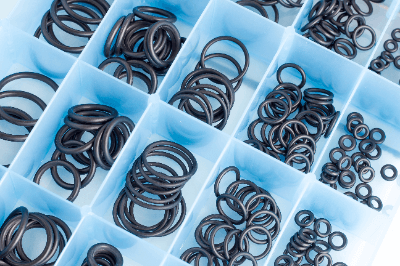What Is an O-Ring?

An O-ring is a seal used to prevent leakage of fluid from a pipe or other object. It is so called because its cross section is circular and shaped like the letter O.
Since it is compressed by the parts to be sealed, the most commonly used materials include are rubber, silicon, or other elastic materials. Although used in the same way as gaskets and packing, O-rings are widely used in various places because of their ease of use, ease of maintenance such as removal, and low cost.
Uses of O-Rings
O-rings are used as sealing materials to prevent leakage of fluid from pipes and other components. They are also used to prevent gases from entering equipment that requires a high vacuum, such as electron microscopes.
O-rings require a groove for the ring in order to be used. This is because the O-ring needs to be compressed in order to seal, allowing it to deform into the proper shape and to apply the proper pressure.
Also, unlike gaskets and packing, O-rings can be used for both fixing and operating. In such cases, it is important to select an O-ring with the appropriate hardness for the location of use.
Principle of O-Rings
O-rings are deformed through compression to close the gap at the sealing area, and they achieve a seal through the repulsive force generated by this compression. Therefore, an O-ring is fitted into a groove for installation. When the O-ring is compressed and pressure is applied, it deforms toward the direction that it protrudes from the groove. Therefore, if the groove is too large, the O-ring will protrude from the member, and deterioration will begin at that point, eventually causing the seal to lose its sealing function.
Also, when fluid pressure increases, the pressure pushes the O-ring out, and the sealing function deteriorates due to overhang. Backup rings can be used to prevent O-ring protrusion. It is recommended that backup rings be used when the fluid pressure is 6.9 MPa or higher.
In addition, when compressing an O-ring with a member of the part to be used, the groove depth should be determined considering the compressing allowance to ensure sealing due to deformation. The appropriate groove depth and O-ring thickness (cross-sectional diameter) can be easily selected by referring to the JIS standard, which specifies groove dimensions so that the compression ratio of the O-ring is approximately 8 to 30% of its thickness.
The JIS standard also specifies the material and hardness of the O-ring, depending on the type and application of the O-ring.
O-Ring Materials
The following are examples of materials used for O-rings:
NBR (Nitrile rubber)
This is the most common material used for O-rings. It has excellent oil and abrasion resistance and stable heat resistance. It is used in general industrial machinery. However, among NBRs, performance is further subdivided according to material numbers in JIS and ISO standards, so it is necessary to check the standards before selecting the appropriate material.
FKM (Fluorine rubber)
This material has excellent heat resistance and oil resistance. Depending on the material number, some materials have excellent resistance to acids and alkalis, and are widely used in equipment that handles chemical solutions. It may also be used in high-pressure equipment or low-temperature equipment. Compared to NBR, it is more expensive. As with NBR, the performance of FFKM is also divided by material number, so it is necessary to check the specifications and applications before deciding on the material.
FFKM (Perfluoroelastomer)
FFKM (Perfluoroelastomer) is a material with excellent heat resistance and the best chemical resistance among synthetic rubbers. Commonly known as Perfluoro. This material is less likely to cause swelling of O-rings due to chemicals. The price is more expensive than FKM, and depending on the size, it is surprisingly priced at around 10,000~/piece. This material is used in cases where leakage of hazardous materials must be prevented.
Various O-rings are produced and sold by major manufacturers. When selecting an O-ring, make an appropriate selection while ensuring uniformity in terms of past performance and inventory management.
O-ring standards (P,G,V)
There are various standards for O-rings, some of which are introduced here.
O-rings that are used most frequently are indicated as P-000, G-000, V-000, etc. The initial letters of each have the following meanings and are used according to the purpose of use.
P (Initial Letter of Packing)
Used as O-rings for exercise and fixation.
G (Initial Letter of Gasket)
Used as O-rings for fixing.
V (Initial Letter of Vacuum)
Used as O-rings for vacuum.
Each of these can be identified by its wire diameter. Each standard has a corresponding table, so it is necessary to check the table when selecting an O-ring.